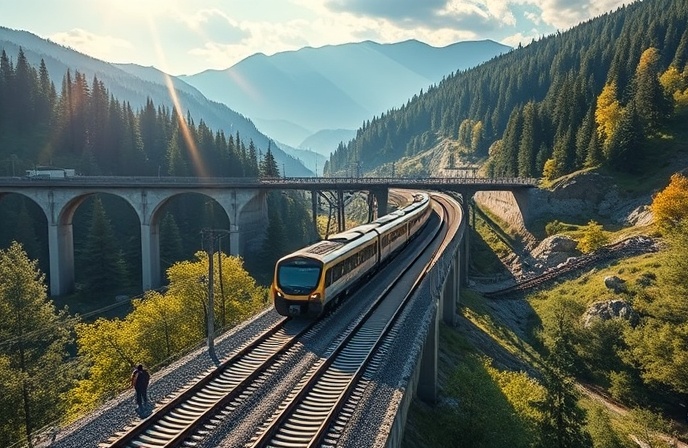DB Cargo’s Vectron Dual Mode: Green Rail Revolution

This article examines the recent order by Deutsche Bahn (DB) Cargo and DB Bahnbau Group for 50 Siemens Vectron Dual Mode locomotives. This significant procurement highlights several key trends within the railway industry: the increasing adoption of dual-mode locomotives for enhanced operational flexibility and environmental sustainability, the strategic importance of framework agreements for large-scale fleet modernization, and the ongoing technological advancements in railway signaling and control systems. The analysis will delve into the specific features of the Vectron Dual Mode locomotive, its contribution to reducing carbon emissions, and the broader implications of this purchase for DB’s overall modernization strategy. Furthermore, we will explore the role of such large-scale procurement deals in driving innovation and shaping the future of sustainable rail transportation. The impact on operational efficiency, maintenance costs, and the overall shift towards greener railway operations will also be considered. This detailed examination offers valuable insights into the evolving landscape of the European railway sector and the strategies employed by major railway operators to achieve their sustainability goals.
The Vectron Dual Mode Locomotive: A Technological Advance
The Siemens Vectron Dual Mode locomotive represents a significant technological leap in railway technology. Its ability to operate seamlessly in both electric and diesel modes offers unparalleled flexibility. On electrified lines, the locomotive operates purely electrically, minimizing emissions. However, its diesel engine allows for operation on non-electrified sections, eliminating the need for time-consuming and costly locomotive changes. This dual-mode capability is particularly beneficial for DB Cargo, which operates on a network encompassing both electrified and non-electrified lines. This adaptability allows for efficient and cost-effective operations across a diverse rail infrastructure. The locomotive’s design, based on the proven Vectron platform and using standardized components, ensures ease of maintenance and lower lifecycle costs compared to purely diesel-powered alternatives. Furthermore, the integration of the Punktförmige Zugbeeinflussung (PZB) (train control system) ensures compliance with German safety regulations.
Sustainability and Cost-Effectiveness: A Double Win
The order underscores DB’s commitment to environmental sustainability. The Vectron Dual Mode’s ability to switch to electric operation on electrified lines significantly reduces CO2 emissions compared to traditional diesel locomotives. This aligns with DB’s broader strategy of decarbonizing its operations and contributing to a more environmentally friendly transportation sector. Beyond environmental benefits, the locomotive’s versatility translates into considerable cost savings. The elimination of locomotive changes reduces operational delays, lowers labor costs, and minimizes the need for maintaining a larger fleet of diesel-only locomotives. This enhanced efficiency contributes to a more sustainable and economically viable railway system.
Strategic Partnerships and Framework Agreements
The order is part of a larger framework agreement signed between DB and Siemens Mobility in 2020, covering up to 400 dual-mode locomotives. This long-term partnership demonstrates a strategic approach to fleet modernization, allowing for phased delivery and predictable budgeting. Framework agreements like this provide significant advantages, facilitating efficient procurement processes, ensuring consistent quality, and promoting collaborative innovation. Such agreements also benefit Siemens Mobility, providing a predictable revenue stream and fostering ongoing innovation in railway technology.
Impact on DB Cargo and DB Bahnbau Group Operations
The delivery of 50 Vectron Dual Mode locomotives will significantly enhance DB Cargo’s operational capabilities. The increase in the Vectron Dual Mode fleet to 146 units will allow for greater flexibility in scheduling, improved route coverage, and increased capacity. The first-time procurement of four locomotives by DB Bahnbau Group signifies their commitment to modernizing their own operations, likely for use in construction and maintenance activities along the railway network. This signifies a broader integration of sustainable technologies throughout the entire DB group, enhancing efficiency and reducing its environmental impact.
Conclusion
The procurement of 50 Siemens Vectron Dual Mode locomotives by DB Cargo and DB Bahnbau Group represents a significant milestone in the ongoing modernization and sustainability efforts of Deutsche Bahn. The order highlights the increasing importance of dual-mode locomotives that offer operational flexibility and substantial environmental benefits, reducing CO2 emissions and operational costs. The strategic framework agreement with Siemens Mobility demonstrates a forward-thinking approach to fleet modernization, ensuring efficient procurement and fostering long-term collaboration. The deployment of these locomotives will enhance DB Cargo’s operational efficiency, expand its capacity, and contribute to a greener railway network. Furthermore, the adoption of the Vectron Dual Mode by DB Bahnbau Group highlights the broader application of sustainable technologies within the DB group. This significant investment in advanced railway technology underscores the commitment of both DB and Siemens Mobility to a more sustainable and efficient future for railway transportation in Europe. The success of this implementation will undoubtedly influence future procurement strategies within the rail industry, promoting the wider adoption of dual-mode locomotives and furthering the development of sustainable railway operations globally. The Vectron Dual Mode’s versatility, coupled with strategic partnerships and long-term planning, positions DB as a leader in the transition towards a cleaner and more efficient railway system. This initiative sets a strong precedent for other railway operators seeking to modernize their fleets while simultaneously minimizing their environmental footprint.



